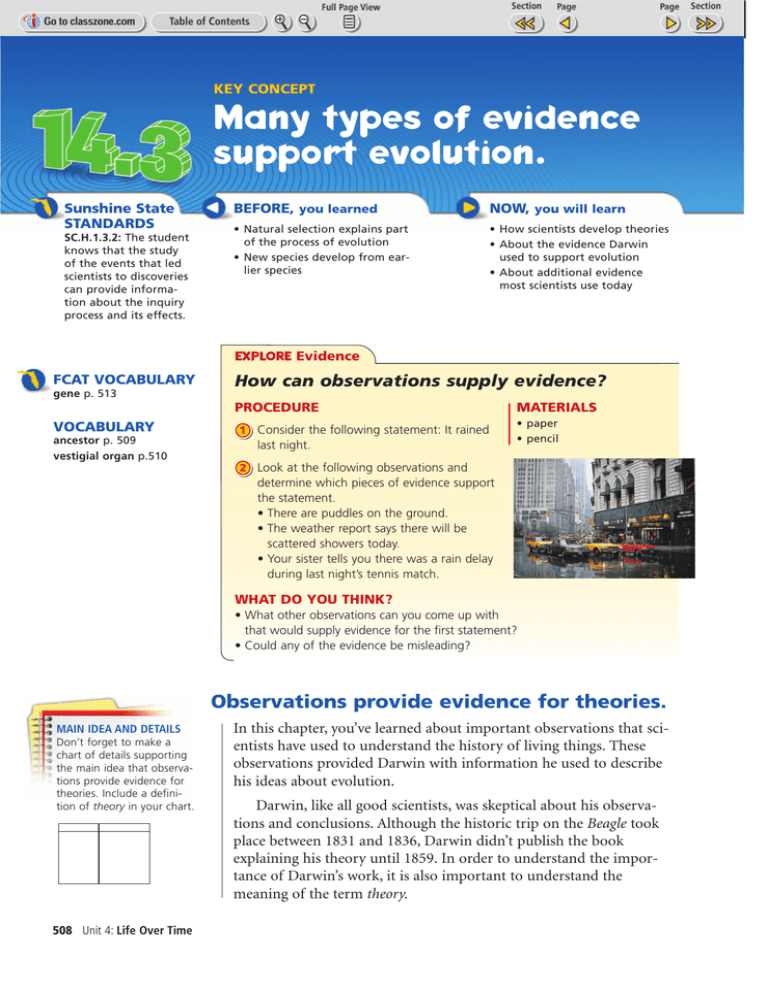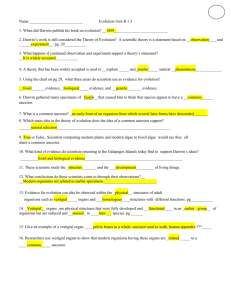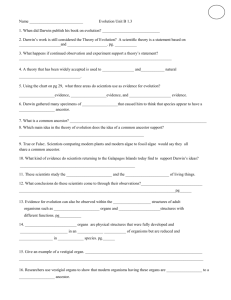Many types of evidence support evolution.
advertisement

KEY CONCEPT Many types of evidence support evolution. Sunshine State STANDARDS SC.H.1.3.2: The student knows that the study of the events that led scientists to discoveries can provide information about the inquiry process and its effects. BEFORE, you learned NOW, you will learn • Natural selection explains part of the process of evolution • New species develop from earlier species • How scientists develop theories • About the evidence Darwin used to support evolution • About additional evidence most scientists use today EXPLORE Evidence FCAT VOCABULARY gene p. 513 How can observations supply evidence? PROCEDURE VOCABULARY ancestor p. 509 vestigial organ p.510 1 Consider the following statement: It rained last night. MATERIALS • paper • pencil 2 Look at the following observations and determine which pieces of evidence support the statement. • There are puddles on the ground. • The weather report says there will be scattered showers today. • Your sister tells you there was a rain delay during last night’s tennis match. WHAT DO YOU THINK? • What other observations can you come up with that would supply evidence for the first statement? • Could any of the evidence be misleading? Observations provide evidence for theories. MAIN IDEA AND DETAILS Don’t forget to make a chart of details supporting the main idea that observations provide evidence for theories. Include a definition of theory in your chart. 508 Unit 4: Life Over Time In this chapter, you’ve learned about important observations that scientists have used to understand the history of living things. These observations provided Darwin with information he used to describe his ideas about evolution. Darwin, like all good scientists, was skeptical about his observations and conclusions. Although the historic trip on the Beagle took place between 1831 and 1836, Darwin didn’t publish the book explaining his theory until 1859. In order to understand the importance of Darwin’s work, it is also important to understand the meaning of the term theory. Evidence: RESOURCE CENTER information from observations and experiments CLASSZONE.COM Evidence for evolution Examine evidence to support evolution. genetic fossil biological Theory: A widely accepted statement based on scientific evidence that helps explain a group of facts A scientific theory is a statement based on observation and experiment. If continued observation and experiment support the statement, it may become widely accepted. A theory that has been widely accepted is used to explain and predict natural phenomena. The chart above will help give you an idea of how a theory works and what evidence has been used to support evolution and the theory of natural selection. Check Your Reading How do scientists support theories? Fossil evidence supports evolution. You have read that Darwin collected many specimens of fossils on his trip. These specimens provided evidence that species existing in the past were very similar to species living during Darwin’s time. For example, the fossil of an extinct animal called the glyptodon resembles the modern armadillo, an animal found today in South America. The geographic information about many fossils provides evidence that two species with a common ancestor can develop differently in different locations. An ancestor is an early form of an organism from which later forms descend. The idea of common ancestors is important to the theory of natural selection and to the evidence that supports the theory. Scientists comparing modern plants and modern algae to fossil algae can tell that they all share a common ancestor. What is a common ancestor? Chapter 14: The History of Life on Earth 509 Biological evidence supports evolution. Today scientists continue to study fossil evidence as well as biological evidence to support the concept of evolution. They have even returned to the Galápagos to further investigate Darwin’s work. What they have found gives strength to the theory he proposed nearly 150 years ago. Returning year after year, these scientists are able to follow and record evolutionary changes as they are unfolding. The biological evidence they study includes the structure and the development of living things. This work has helped scientists identify relationships between organisms that exist today. In addition, their observations suggest how modern organisms are related to earlier species. Similarities in Structure Evidence for evolution can be observed within the physical structures of adult organisms. Scientists who study evolution and development consider two types of structural evidence. They are vestigial (veh-STIHJ-ee-uhl) organs and similar structures with different functions. Check Your Reading reading tip The root of the word vestigial means “footprint.” A vestige refers to visible evidence that is left behind—such as a footprint. What are two types of structural evidence? are physical structures that were fully developed and functional in an ancestral group of organisms but are reduced and unused in the later species. In the bodies of whales there are small leg bones that are vestigial. The skeletons of snakes also have traces of leglike structures that are not used. These vestigial organs help researchers see how some modern organisms are related to ancestors that had similar structures. Vestigial organs Similar structures with different functions Scientists studying the anatomy of living things have also noticed that many different species share similar structures. But these structures are used differently by each species. For example, lizards, bats, and manatees have forelimbs that have a similar bone structure. As you can see from the diagram on page 511, there is one short bone and one long bone that go from a shoulder structure to a wrist structure. But obviously, a lizard, a bat, and a manatee use this structure in different ways. This similarity in structure indicates that these organisms shared a common ancestor. The process of natural selection caused the variations in form and function that can be observed today. These organisms lived in different environments and so were under different pressures. For lizards the environment was land, for bats it was the air, and for manatees the water. The environment influenced the selection of traits. 510 Unit 4: Life Over Time Biological Evidence for Evolution Scientists learn about common ancestors by looking at physical structures. Vestigial Structures The small, leglike bones in modern whales indicate that an early ancestor may have had legs. Ambulocetus, an extinct whalelike animal with four legs modern whale Similar Structures, Different Functions gecko lizard little brown myotis bat manatee These animals share a similar bone structure that they use in very different ways. The presence of this similar structure indicates a common ancestor. Chapter 14: The History of Life on Earth 511 reading tip As you read about the development of a chicken, rabbit, and salamander, study the diagram below. Similarities in Development Scientists in the 1700s were fascinated by the fact that various animals looked similar in their earliest stages of life. They noted that as the organisms developed, they became less and less alike. Today’s scientists continue to compare the developmental stages of different species. The adult stages of many species do not look similar. For example, a rabbit does not look anything like a chicken. However, study reveals that the early life stages of a chicken and a rabbit are similar. An organism that is in an early stage of development is called an embryo. In the diagram below, notice the development of three different species: a chicken, a rabbit, and a salamander. In the early stages of development, the embryos of all three organisms look similar. As they continue to develop, they begin to take on distinct characteristics. The chicken has a structure that starts to resemble a beak. The salamander begins to look as if it is adapted for life near water. In their adult stages, these three species no longer look similar. Similarities in Development The study of embryos shows that animals that appear to be very different as adults are similar during early development. Early Development: Embryos Adults 512 Unit 4: Life Over Time Genes How can a sequence communicate information? SKILL FOCUS Sequencing PROCEDURE 1 MATERIALS From your pile of letters (A, D, E, R), spell out the word RED. 2 Working with a partner, use the letters to spell two more words having three letters. letter cards TIME 20 minutes WHAT DO YOU THINK? How does rearranging the letters change the meaning of the words? CHALLENGE Cut out words from a newspaper. Arrange these words to form different phrases. How do these phrases communicate different messages? Genetic evidence supports evolution. The key to understanding how traits are passed from one generation to the next lies in the study of DNA, the genetic material found in all organisms. DNA contains the information all organisms need to grow and to maintain themselves. When organisms reproduce, they pass on their genetic material to their offspring. DNA contains a code that a cell uses to put together all the materials it needs to function properly. The code is made up of four different chemical subunits called bases. The bases are symbolized by the four letters A, T, C, and G. Located within DNA are individual genes. A gene is a segment of DNA that relates to a specific trait or function of an organism. Each gene has a particular sequence of bases. The cell takes this sequence and translates it into the chemicals and structures the organism needs. VOCABULARY Remember to make a frame game for gene. Scientists studying genes have identified a gene called the clock gene in many mammals. This particular gene relates to the function of sleeping and waking. As scientists learn more they can identify patterns of behavior in different organisms. The chart on page 514 compares the DNA sequence of part of the clock gene in both humans and mice. What is a gene? Chapter 14: The History of Life on Earth 513 Comparing Genes Humans and mice look very different, but the DNA that makes up their genes is surprisingly similar. DNA Sequence clock gene sequence begins here Human Mouse Human Mouse The bar shows where the mouse and human DNA are different. Human Mouse Human Mouse The letters represent different subunits of DNA. FLORIDA Content Preview reminder Scientists have learned a great deal about human DNA, which you will study in grade 8. Scientists can tell how closely organisms are related by comparing their DNA. The more matches there are in the sequence of bases between two organisms, the more closely related they are. For example, almost all the genes found in a mouse are also found in a human. Even though the two organisms appear so different, much of the functioning of their cells is similar. KEY CONCEPTS CRITICAL THINKING 1. Describe in your own words how scientists use the word theory. 4. Analyze Describe three characteristics of a scientific theory. Explain how Darwin’s theory of evolution is an example of a scientific theory. 2. What type of evidence did Darwin use to support his theory of evolution? 3. Identify three different types of evidence that today’s scientists use to support the theory of evolution. 514 Unit 4: Life Over Time CHALLENGE 5. Predict If you were looking at the sequence within the genes of two species, how would you predict that the two species are related?

